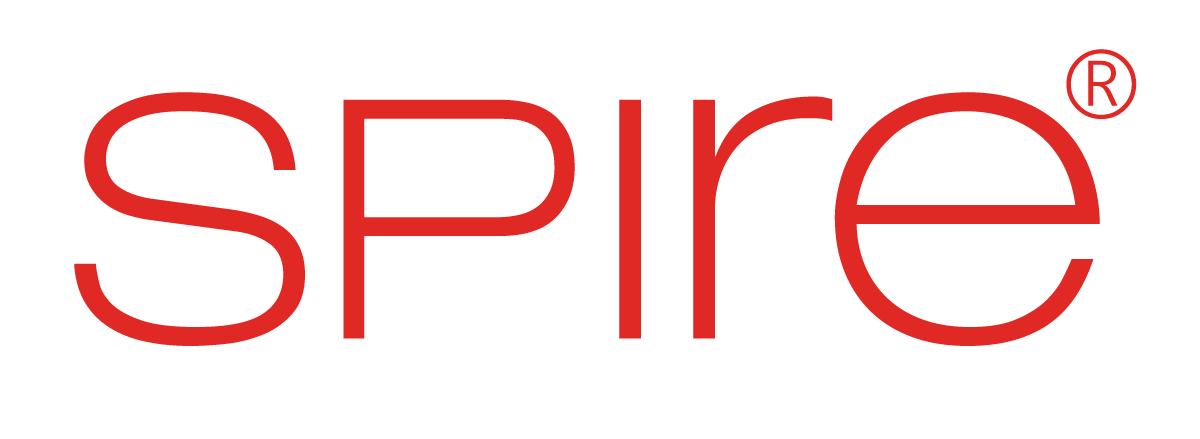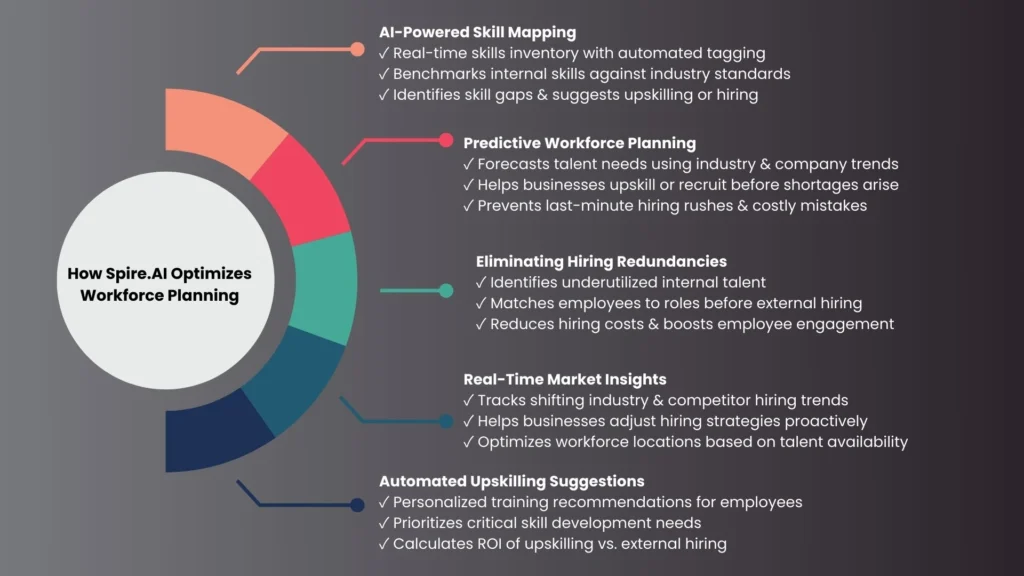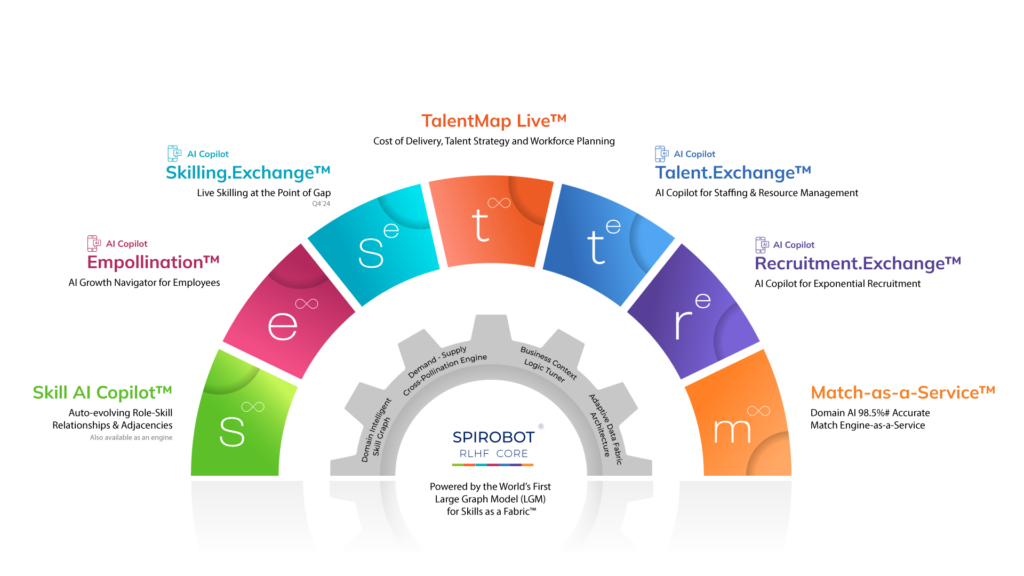Workforce planning has always been a delicate balancing act. Organizations try to predict hiring needs, assess employee skills, and ensure the right people are in the right roles, all while industries shift under their feet. Traditionally, this has been a process full of guesswork, outdated spreadsheets, and costly hiring mistakes.
AI-driven workforce planning is a game-changing approach that uses real-time skill data to optimize hiring, reduce redundancies, and align workforce capabilities with business goals.
At the forefront of this revolution is Spire.AI, a solution designed to help businesses stay ahead of workforce challenges by leveraging real-time, AI-powered insights.
So, how exactly does AI-driven workforce planning work, and why should organizations start paying attention? Let’s break it down.
Why Traditional Workforce Planning Falls Short
Most companies still rely on manual processes or predictive models based on outdated trends to plan their workforce. This approach is riddled with inefficiencies, leading to costly hiring mistakes and misaligned workforce strategies. Here’s a deeper look at why traditional workforce planning methods don’t work anymore.
1. Delayed Skill Mapping
By the time HR teams recognize a skill gap, it’s often too late to train employees or hire the right talent. Traditional workforce planning relies on historical data, meaning skill assessments are always lagging behind current business needs. For example –
- An organization may only realize it lacks AI and automation specialists after struggling to implement new technologies.
- The hiring process then becomes reactive, leading to increased competition for talent, higher recruitment costs, and possible project delays.
As traditional models don’t offer real-time skill insights, organizations struggle to keep pace with market shifts.
2. Reactive Hiring Instead of Strategic Workforce Development
Without data-driven insights, businesses tend to make last-minute hiring decisions based on short-term needs rather than strategic workforce planning.
- Imagine a retail company suddenly realizing it needs eCommerce experts to expand its online presence.
- Without workforce forecasting, it resorts to expensive, last-minute hiring, often overpaying for talent or making rushed hiring decisions.
This lack of foresight leads to unnecessary costs and hiring inefficiencies.
3. Overlooked Internal Talent Leading to Hiring Challenges
Many organizations hire for positions they don’t actually need because they lack visibility into internal talent capabilities.
- An organization might recruit data analysts while already employing finance professionals with data analytics skills.
- Without a system to recognize existing talent potential, companies end up duplicating roles, leading to wasted salaries and training expenses.
A better approach would be to upskill current employees, reducing hiring redundancies while optimizing existing talent.
4. Workforce Planning Is Disconnected from Business Strategy
One of the biggest flaws in traditional workforce planning is the disconnect between hiring and business goals. Many HR teams work in isolation, following rigid headcount models rather than aligning talent strategy with corporate objectives.
For example:
- A tech company planning to expand into AI-based services should prioritize AI talent development in workforce planning.
- Without AI-driven insights, hiring might focus on traditional IT roles, leaving the organization ill-prepared for its strategic shift.
This misalignment often leads to missed growth opportunities, increased costs, and skill shortages in critical areas.
How AI Transforms Workforce Planning
AI-driven workforce planning removes guesswork by analyzing real-time skill intelligence, automating hiring decisions, and ensuring businesses stay ahead of workforce challenges.
1. Real-Time Skill Analysis
AI can scan workforce databases, job descriptions, and market data to map existing employee skills against emerging industry trends.
- If AI detects that cybersecurity expertise is in growing demand, it alerts HR and leadership teams to prioritize training programs or hiring.
- AI can also track individual employees’ skill development, ensuring workforce skills remain relevant.
This allows organizations to proactively upskill employees, reducing reliance on external hiring.
AI-driven workforce planning revolutionizes talent management by leveraging real-time skill intelligence, predictive hiring models, and internal talent optimization.
By analyzing workforce data and industry trends, AI enables organizations to proactively upskill employees, anticiptate talent needs and eliminate redundant hiring. This strategic approach ensures alignment between workforce capabilities and business goals, fostering agility and efficiency in an evolving job market.
2. Predictive Hiring Models
AI forecasts talent needs based on real-time industry trends, business goals, and internal workforce analytics.
- If AI detects a rising demand for blockchain developers, it advises leadership to train existing software engineers or hire before the market becomes competitive.
- AI can also predict attrition risks, helping companies retain employees before they leave.
This predictive hiring approach helps prevent talent shortages while optimizing hiring costs.
3. Eliminating Hiring Redundancies
AI scans internal databases to identify hidden skills within the workforce, reducing the need for external hires.
- If a company needs a UX designer, AI may find an existing employee with UX experience in a different department.
- Instead of hiring externally, the company can redeploy internal talent, saving hiring and onboarding costs.
This maximizes workforce efficiency and reduces unnecessary hiring expenses.
4. Aligning Workforce with Business Strategy
AI ensures hiring and workforce planning align with a company’s long-term business vision.
For example:
- An organization planning to expand into AI-driven customer service can use AI to identify internal candidates with chatbot development skills before investing in external recruitment.
- AI also monitors evolving business priorities, automatically adjusting workforce strategies in response to shifts in corporate objectives.
This direct connection between workforce planning and business goals ensures that talent strategies support growth rather than react to it.
How Spire.AI Optimizes Workforce Planning
Spire.AI delivers a Domain-Intelligent, AI-driven workforce planning platform that transforms workforce strategy from a reactive, guesswork-based process into a data-backed, proactive approach. Leveraging the Large Graph Model (LGM) for Skills, Spire.AI enables organizations to accurately map, forecast, and optimize their workforce by recognizing real-time skill dynamics. Let’s explore its key features in detail.
1. AI-Powered Skill Mapping: A Real-Time Workforce Intelligence Engine
One of the biggest challenges in workforce planning is knowing exactly what skills exist within an organization and identifying hidden or underutilized talent. Traditional methods rely on static HR databases, self-reported skills, and outdated performance reviews, leading to inaccurate assessments.
Spire.AI revolutionizes this by using LGM for Skills, an advanced AI construct trained on millions of job roles, industry benchmarks, and real-world skills applications to dynamically assess and tag employee skills in real time.
How It Works:
- Domain-Intelligent Skill Extraction: Spire.AI analyzes structured and unstructured workforce data (resumes, project contributions, performance reviews) to identify actual skills rather than relying on job titles or self-assessments.
- AI-Powered Competency Benchmarking: It compares internal skill levels against industry standards, providing clear visibility into where employees excel or need upskilling.
- LGM-Driven Gap Analysis: Using LGM for Skills, Spire.AI identifies gaps in expertise and recommends whether to upskill existing talent or hire externally.
Instead of waiting until a skill gap becomes a crisis, businesses can act preemptively, ensuring their workforce is always prepared for industry shifts.
2. Predictive Workforce Planning: Forecasting Talent Needs Before They Arise
Instead of hiring reactively, Spire.AI predicts future talent demands by analyzing industry trends, internal workforce dynamics, and company growth trajectories.
How Spire.AI Forecasts Talent Needs:
- AI-Powered Trend Analysis: The platform tracks hiring patterns across industries, detecting emerging high-demand skills before they become critical.
- Internal Workforce Projections: It assesses retirement trends, employee career trajectories, and team productivity metrics to predict internal shifts.
- Company Growth Alignment: Spire.AI integrates with business strategy data, ensuring workforce plans align with expansion goals.
Example Scenario:
A cybersecurity company aims to expand into cloud security but lacks trained professionals.
- Spire.AI predicts a rising demand for cloud security specialists in the next 12 months.
- Instead of scrambling for external hires, the company proactively upskills existing cybersecurity engineers or begins hiring ahead of market competition.
With AI-driven foresight, organizations avoid last-minute recruitment struggles and strategically build their future workforce.
3. Eliminating Hiring Redundancies: Smarter Talent Utilization
One of the biggest inefficiencies in workforce planning is hiring externally for skills that already exist internally leading to wasted recruitment costs and underutilized employees.
Problem:
A company hires a data scientist externally while already having business analysts proficient in Python and machine learning.
How Spire.AI Fixes It:
- Domain-Intelligent AI Scanning: The system maps existing workforce capabilities in-depth, recognizing hidden or evolving skill sets.
- LGM for Skills Talent Matching: Instead of relying on job titles, Spire.AI matches employees to roles based on demonstrated skills and competencies.
- Internal Mobility Recommendations: The platform suggests role transitions or upskilling paths, ensuring employees are placed in optimal positions before new hires are considered.
By preventing redundant hiring and unlocking internal talent, companies cut hiring costs while maximizing workforce potential.
4. Real-Time Market Insights: Keeping Workforce Strategies Competitive
Effective workforce planning requires external intelligence, not just internal assessments. Spire.AI continuously tracks and analyzes global talent market trends to ensure businesses stay competitive.
What Spire.AI Monitors:
- Shifting Industry Trends – Detects rising and declining demand for skills (e.g., increase in AI engineers, decline in legacy programming skills).
- Competitor Hiring Patterns – Tracks competitors’ job postings to identify which roles and skills are being prioritized.
- Regional Talent Availability – Identifies where skilled professionals are located, helping businesses optimize hiring locations or remote work strategies.
How This Benefits Companies:
- Adjust hiring strategies in real time based on labor market shifts.
- Gain a competitive edge by targeting in-demand skills before competitors.
- Optimize workforce distribution by sourcing talent from cost-effective locations.
Instead of relying on outdated market reports, Spire.AI provides live workforce intelligence, ensuring companies always stay ahead of industry trends.
5. Automated Upskilling Suggestions: Future-Proofing the Workforce
Hiring externally isn’t always the best solution, upskilling existing employees is often more cost-effective and sustainable.
Spire.AI leverages LGM-driven skills analysis to provide:
- Personalized Learning Pathways: Tailored course, certification, and training recommendations aligned with employee strengths and industry needs.
- AI-Powered Training Prioritization: Showcases which skills should be developed based on business impact and workforce trends.
- ROI-Based Upskilling Decisions: Compares the cost-benefit of training employees vs. external hiring, ensuring optimal investment in talent development.
By integrating AI-powered upskilling into workforce planning, businesses reduce long-term hiring costs while fostering a culture of continuous learning and career growth.
Why Businesses Should Adopt Spire.AI
According to Deloitte, 72% of companies say workforce planning is a top priority, but only 18% feel confident in their ability to do it well.
With Spire.AI, companies can:
- Reduce workforce costs by up to 30% through smarter hiring and internal talent utilization.
- Increase workforce efficiency by 40% by ensuring skills align with long-term business goals.
- Improve retention rates by offering targeted career growth opportunities.
Spire.AI isn’t just a workforce planning tool—it’s a competitive advantage.
By combining real-time skill mapping, predictive hiring models, internal talent optimization, and automated upskilling, Spire.AI ensures companies stay ahead of industry shifts—before they even happen.
Final Thoughts: The Future of AI-Driven Workforce Planning With Spire.AI
Spire.AI represents the next evolution of workforce planning, one that’s data-driven, proactive, and highly intelligent. By using Domain-Intelligent AI, businesses no longer have to guess their way through hiring and talent management.
Ready to take your workforce planning to the next level? Explore Spire.AI and gain the strategic workforce advantage your organization needs.







